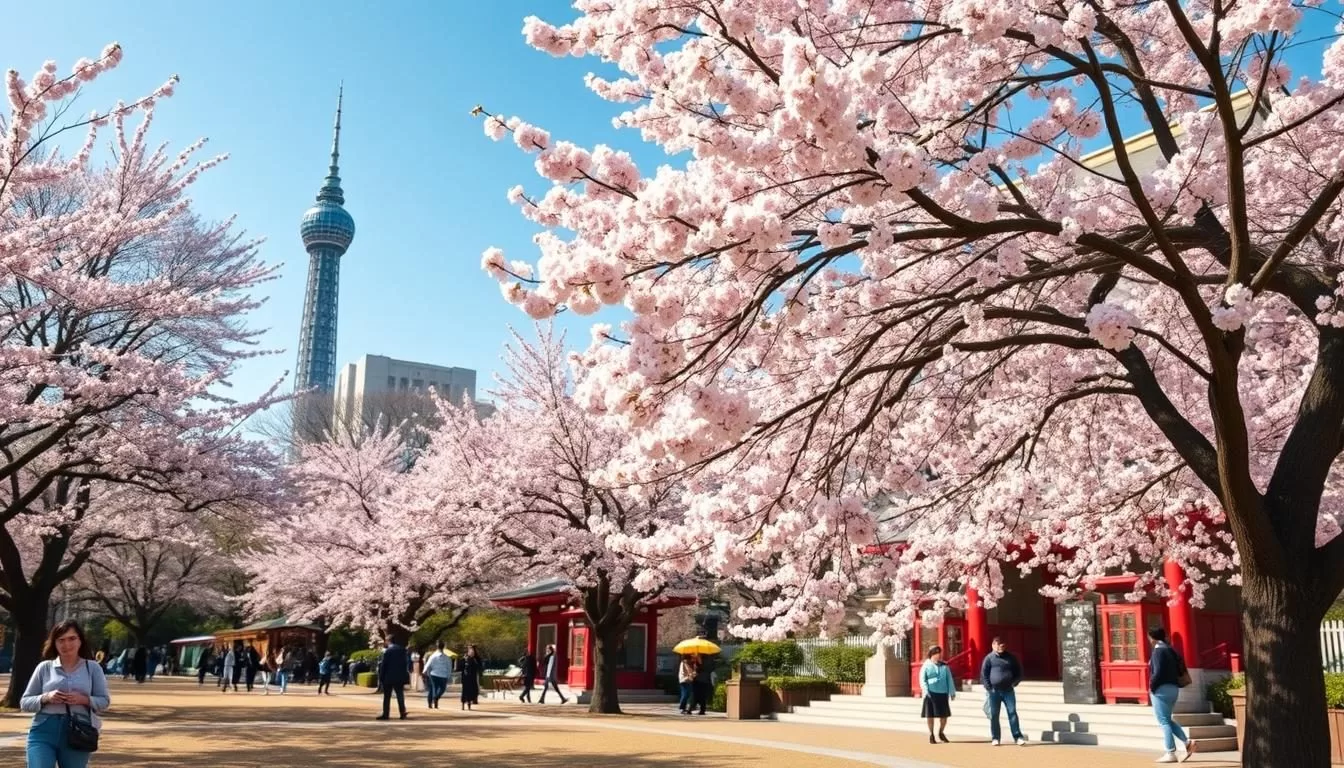✓ Accommodations✓ Flights✓ Rental Cars✓ Tours & Activities
Discover the Beauty and Culture of Ueno Park
In the heart of Tokyo lies Ueno Park, a treasure trove of Japanese culture, history, and natural beauty. As one of Japan’s five oldest public parks, Ueno Park has been a beloved destination since it opened to the public in 1873.
Officially known as Ueno Onshi-Koen, or “the Ueno Imperial Gift Park,” this expansive green space is renowned for its Ueno Zoo, numerous world-class museums, and spectacular cherry blossoms in the spring.
You’ll discover one of Tokyo’s most cherished green spaces, combining natural beauty with cultural significance. Ueno Park offers a perfect blend of history, art, nature, and entertainment, making it a must-visit destination for travelers to Tokyo.
The park is home to various attractions, including historic temples, beautiful gardens, and seasonal events. Whether you’re interested in art, history, wildlife, or simply enjoying a peaceful stroll, Ueno Park has something for every visitor.
- Explore world-class museums and historic temples within the park.
- Enjoy the beautiful gardens and seasonal attractions.
- Experience the local culture and history.
The History of Ueno Park
As you stroll through Ueno Park, you’re walking on grounds steeped in history. The park’s story begins with its origins as part of Kaneiji Temple, a significant religious site during the Edo period.
From Temple Grounds to Public Park
The transformation of Ueno Park from sacred temple grounds to a public space is a pivotal moment in Japan’s modernization. Originally, Kaneiji Temple was one of the city’s largest and wealthiest temples, serving as a family temple for the Tokugawa clan. After suffering extensive damage during the Boshin Civil War in 1868, the temple grounds were repurposed. In 1873, the area was converted into one of Japan’s first Western-style public parks, marking a significant shift towards modernization.
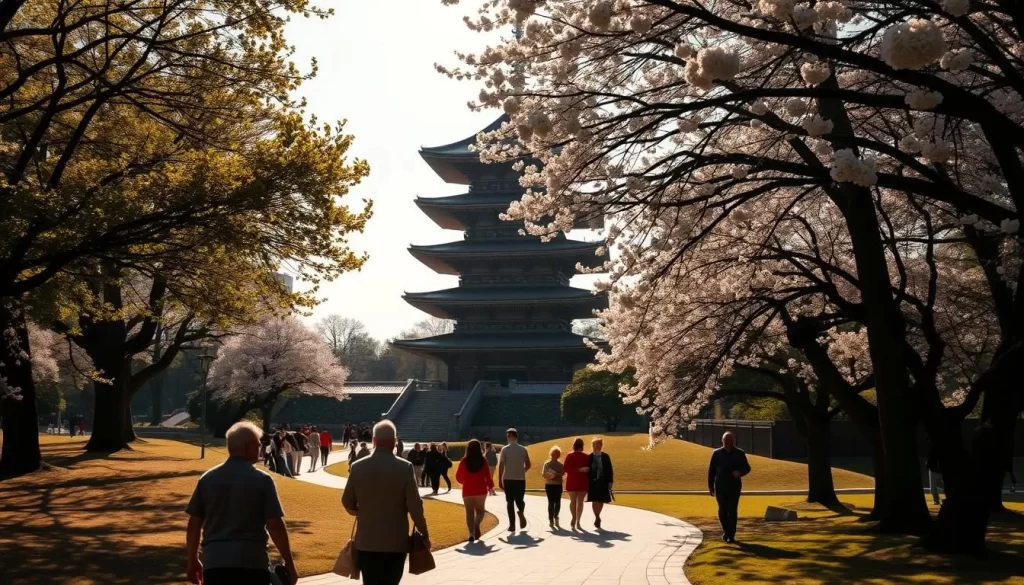
The Significance of Kaneiji Temple
Kaneiji Temple was not only a religious site but also a strategic location, built to protect the city from evil spirits according to traditional beliefs. Its historical significance continues to influence the atmosphere of Ueno Park today. As you explore the park, you can still find remnants of the original temple complex, offering glimpses into its storied past and the role it played in the city’s history.
The legacy of Kaneiji Temple and its transformation into Ueno Park is a testament to the city’s ability to blend tradition with modernity, creating a unique cultural landscape that honors its history while embracing the present.
Getting to Ueno Park
Getting to Ueno Park is convenient, thanks to its comprehensive transit network. The park is a hub for various train, subway, and shinkansen lines, making it easily accessible from different parts of Tokyo.
By Train and Subway
You can reach Ueno Station via the JR Yamanote Line, which connects major areas like Shinjuku, Shibuya, and Tokyo Ueno. The Tokyo Metro subway lines (Ginza and Hibiya) also stop at Ueno, providing additional options. When arriving by JR train, simply exit through the “Park Exit” at Ueno Station and find yourself directly across from the park entrance.
From Major Tokyo Landmarks
Ueno Park is just a short train ride away from major Tokyo landmarks. For instance, Tokyo Station is only four stops away on the Yamanote Line. You can also reach Ueno from Narita Airport via the Keisei Skyliner, making it a convenient destination for international travelers.
| Transportation Method | Route | Travel Time |
|---|---|---|
| JR Yamanote Line | Tokyo Station to Ueno Station | 4 stops |
| Keisei Skyliner | Narita Airport to Ueno | Approximately 60-90 minutes |
| Tokyo Metro | Ginza/Hibiya Lines to Ueno | Varies by starting location |
Park Hours and Admission Information
To make the most of your day at Ueno Park, familiarize yourself with the park’s hours of operation and admission policies. Ueno Park is accessible to visitors free of charge, making it an attractive destination for travelers on a budget.
Opening Hours for the Park and Attractions
The park grounds are open from 5:00 AM to 11:00 PM, providing flexibility for morning walks or evening strolls. Most attractions within the park, such as museums, operate from around 9:00 or 9:30 AM to between 4:00 and 5:30 PM.
Entrance Fees and Passes
While entering Ueno Park is free, attractions like museums and the zoo require separate tickets, typically costing around 600 yen. Consider purchasing combination tickets or day passes if you plan to visit multiple attractions to save on admission fees.
| Attraction | Opening Hours | Admission Fee |
|---|---|---|
| Ueno Park | 5:00 AM – 11:00 PM | Free |
| Museums | 9:00/9:30 AM – 4:00/5:30 PM | Around 600 yen |
| Ueno Zoo | 9:30 AM – 5:00 PM | Around 600 yen |
Ueno Park, Tōkyō, Japan: Visitor Information Overview
As you plan your visit to Ueno Park in Tōkyō, Japan, understanding the layout and the best times to visit can greatly enhance your experience. Ueno Park is famous for its excellent galleries and museums, the pandas at Ueno Zoo, the Shinobazu Pond, and the historic Ueno Toshogu Shrine, with its cherry blossoms being a major draw.
Park Layout and Map
Ueno Park sprawls across 133 acres, offering a variety of attractions strategically positioned throughout the grounds. The park’s layout features a main central pathway lined with cherry trees, with museums clustered in the northern section and natural attractions like Shinobazu Pond to the south. You can easily spend a full day exploring the park, so prioritizing attractions based on your interests is recommended if your time is limited.
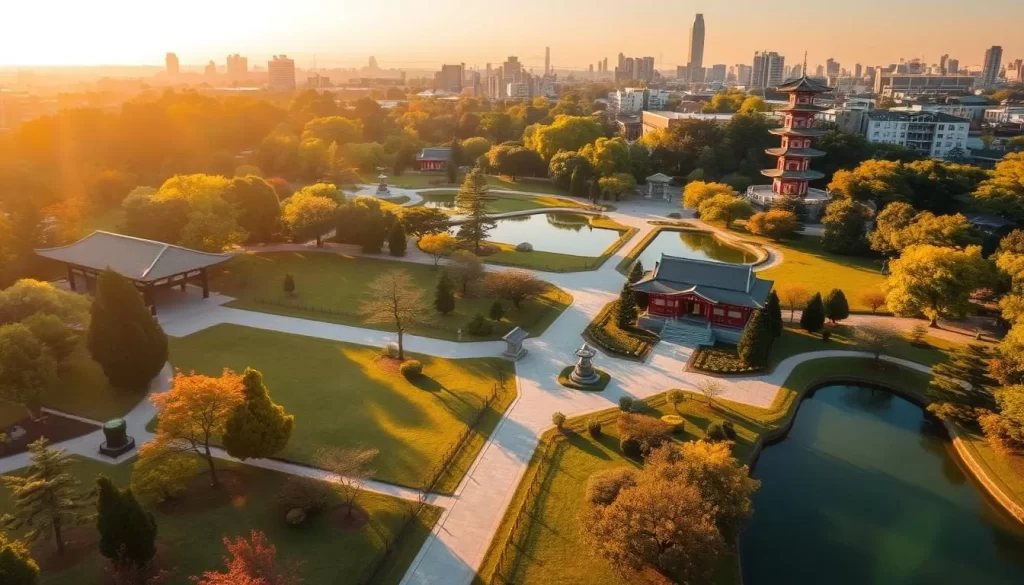
Best Times to Visit
When planning your visit, consider that spring (late March to early April) brings spectacular cherry blossoms but also the largest crowds of the year. You might prefer autumn for its beautiful foliage and more moderate visitor numbers, or winter for a quieter experience with fewer tourists. Early mornings and weekdays generally offer the most peaceful experience, while weekends and holidays tend to be significantly more crowded.
| Season | Highlights | Crowd Level |
|---|---|---|
| Spring | Cherry Blossoms | High |
| Autumn | Beautiful Foliage | Moderate |
| Winter | Quiet Experience | Low |
Museums and Art Galleries
With its array of museums and art galleries, Ueno Park is a must-visit destination for art lovers and history enthusiasts alike. The park is home to some of Japan’s most prestigious cultural institutions, offering a diverse range of exhibits that cater to various interests.
Tokyo National Museum
The Tokyo National Museum is Japan’s oldest and largest museum, housing an extensive collection of Japanese art and antiquities across multiple buildings. As you explore the museum, you’ll discover a vast array of artifacts, including ancient pottery, samurai armor, and intricate woodblock prints.
National Museum of Western Art
The National Museum of Western Art boasts an impressive collection of Western art, featuring masterpieces by European artists such as Monet, Renoir, and Rodin. The museum’s building, designed by Le Corbusier, is itself a work of art and a significant part of the cultural landscape.
Tokyo Metropolitan Art Museum
The Tokyo Metropolitan Art Museum hosts rotating special exhibitions from around the world, providing fresh artistic experiences with each visit. From contemporary installations to classical masterpieces, the museum’s diverse exhibitions cater to a wide range of artistic tastes.
National Museum of Nature and Science
At the National Museum of Nature and Science, you’ll find fascinating exhibits on Japan’s natural history, global ecosystems, and scientific advancements. The museum offers a unique blend of science and nature, making it an engaging destination for visitors of all ages.
- Discover Japan’s rich cultural heritage at the Tokyo National Museum.
- Explore masterpieces by European artists at the National Museum of Western Art.
- Enjoy rotating exhibitions at the Tokyo Metropolitan Art Museum.
- Learn about Japan’s natural history at the National Museum of Nature and Science.
Ueno Zoo: Home to Giant Pandas
Ueno Zoo, Japan’s oldest and most beloved zoo, is a must-visit attraction within Ueno Park. As home to over 2,500 animals from 350 different species, it’s a haven for wildlife enthusiasts.
The zoo is divided into two main areas: the West Area and the East Area, connected by a monorail that offers a unique perspective on the animal habitats.
West Area Highlights
The West Area is a treat for families and animal lovers alike, featuring the Children’s Zoo, African savanna animals, and the Small Mammal House. Here, you can get up close with a variety of species, making for a memorable visit.
- Explore the Children’s Zoo for interactive animal encounters.
- See African savanna animals in a spacious habitat.
- Discover small mammals from around the world.
East Area Attractions
The East Area is equally captivating, with attractions that include Asian elephants, tigers, gorillas, and a serene Japanese-style garden complete with a five-story pagoda. This area showcases the diversity of wildlife from Asia and beyond.
- Visit the Asian elephants and learn about conservation efforts.
- Observe majestic tigers and gorillas in their habitats.
- Enjoy the tranquil Japanese garden and pagoda.
Ueno Zoo is not just a place to see animals; it’s an educational experience that highlights the importance of conservation. As one Japan‘s most cherished zoos, Ueno Zoo continues to attract visitors from across the globe, especially those eager to see its famous giant pandas.
Historic Temples and Shrines
The historic temples and shrines within Ueno Park offer a glimpse into Japan’s spiritual heritage and cultural significance. Ueno Park has a deep connection with some of the most important events in modern Japanese history, and its temples and shrines are a reflection of that.
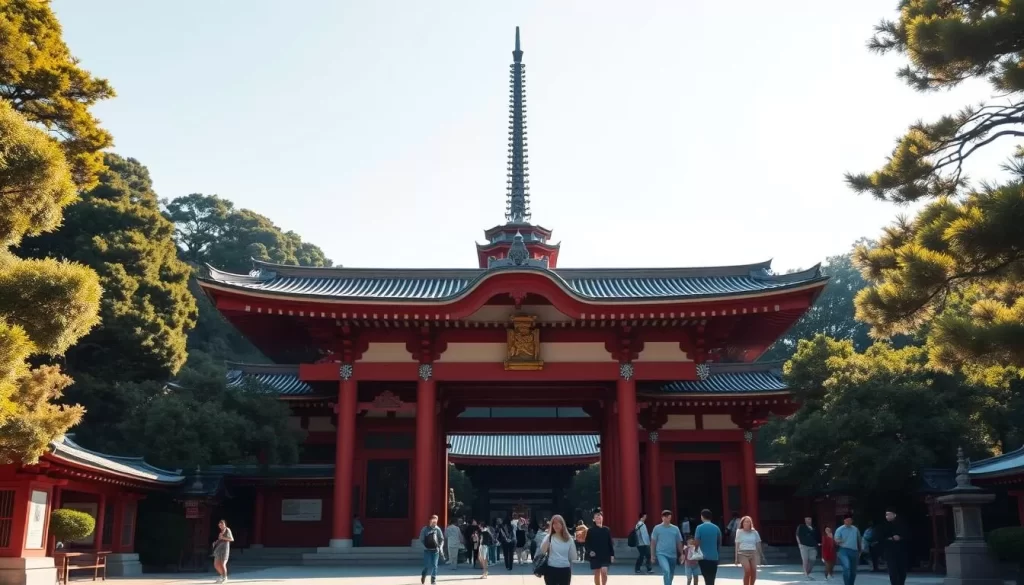
Ueno Toshogu Shrine
The Ueno Toshogu Shrine, dedicated to Ieyasu, the first Tokugawa shogun, is a Cultural Property of Japan. Constructed in 1627, it has survived wars and earthquakes, featuring stunning gold leaf decorations and intricate carvings. As a significant shrine, it provides insight into Japan’s historical and spiritual practices.
Kaneiji Temple
Kaneiji Temple, once one of Tokyo’s largest Buddhist temples, now exists in a more modest form within Ueno Park. Originally part of the grounds where some members of the Tokugawa family are buried, it reflects the park’s historical significance.
Kiyomizu Kannon Temple
Kiyomizu Kannon Temple, inspired by Kyoto’s famous Kiyomizudera, offers a peaceful sanctuary. Visitors can observe traditional Japanese spiritual practices and architectural styles, experiencing the blend of tradition and innovation.
Some key experiences to look out for include:
- Exploring the Ueno Toshogu Shrine and its beautiful decorations
- Visiting Kaneiji Temple to understand its historical significance
- Finding peace at Kiyomizu Kannon Temple
Shinobazu Pond and Bentendo Hall
As you explore Ueno Park, you’ll discover Shinobazu Pond, a captivating body of water with a rich history. Located at the southwestern end of the park, this pond is one of many reminders of Kaneiji Temple’s former grandeur. The pond represents Lake Biwako, symbolically recreating Kyoto’s sacred landscape within Tokyo.
Lotus Flowers in Summer
During the summer months, Shinobazu Pond transforms into a breathtaking spectacle as thousands of lotus flowers bloom across its surface. The lotus flower, associated with purity, rebirth, and Buddhism in Japan, creates a sacred and magical atmosphere that should not be missed. This natural display is a highlight of visiting the pond during the warmer seasons.
Paddle Boat Rentals
For a unique perspective on the surrounding park, you can rent paddle boats to navigate Shinobazu Pond’s waters. This activity offers a fun and relaxing way to enjoy the scenery, making it an ideal experience for couples and families. As you glide across the pond, you’ll appreciate the serene beauty of this special place within Ueno Park.
Cherry Blossom Season at Ueno Park
With over 1,000 cherry trees, Ueno Park is one of Tokyo’s most iconic cherry blossom viewing spots. The park’s central pathway is lined with these beautiful trees, creating a breathtaking spectacle that attracts more than 2 million visitors each year.
When to See the Sakura
The cherry blossoms in Ueno Park typically bloom in late March to early April. This period is considered the peak season for hanami (flower viewing) parties, where people gather to admire the beauty of the blossoms. The exact timing can vary from year to year, depending on weather conditions.
Hanami Traditions and Events
During the cherry blossom season, Ueno Park becomes a vibrant hub of activity. Visitors can participate in traditional hanami parties, enjoying food, drinks, and the company of others under the blooming trees. The park is especially magical in the evenings when it’s illuminated with lanterns, creating a perfect atmosphere for cherry blossom viewing.
The Statue of Saigo Takamori
Near the southern entrance of Ueno Park stands a remarkablestatueof Saigo Takamori, a figure synonymous with Japan’ssamuraihistory. Thestatuedepicts Takamori walking his dog, a poignant representation of a man who played a pivotal role in shaping Japan’shistory.
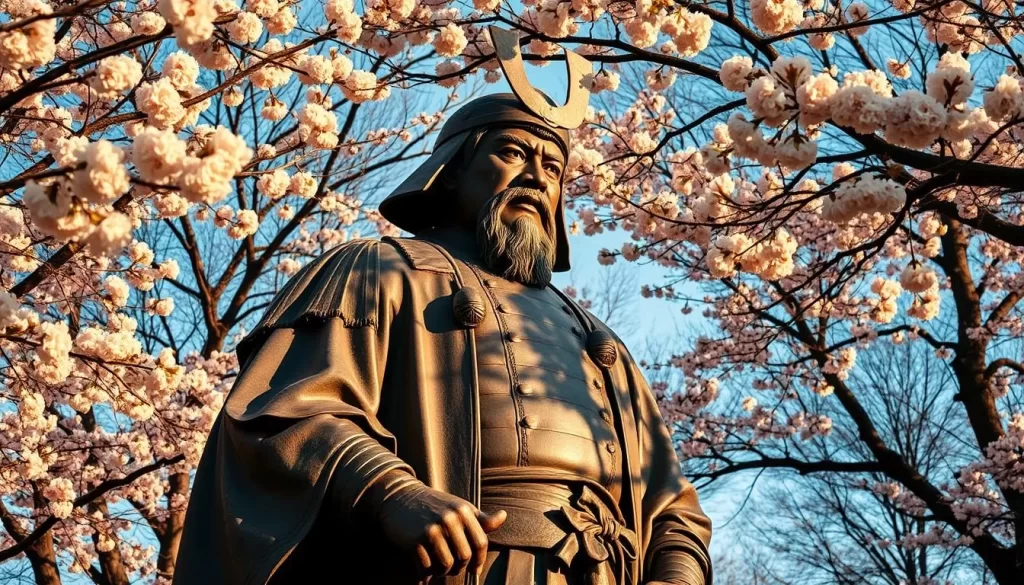
A Legendary Samurai
Saigo Takamori is often referred to as the “last true samurai.” He was a complex figure who led a roller-coaster life, from being a rural farmer-samurai to a Meiji-era politician. His legacy is marked by loyalty, valor, and significant contributions to Japan’s modernization.
Historical Significance
Thestatueis historically significant, commemorating Saigo’s role in the Battle of Ueno in 1868, fought on the grounds that are now part of Uenopark. Today, the statue serves as a popular meeting point and a must-photograph landmark, symbolizing Takamori’s enduring impact on Japanesehistoryand the values he represented as asamurai.
Shitamachi Museum: Glimpse into Old Tokyo
Tucked away in Ueno Park, the Shitamachi Museum offers a unique glimpse into Tokyo’s past. This lesser-known museum is noteworthy for its portrayals of Tokyo’s history and everyday life during the late Edo and early Meiji periods.
Exhibits and Collections
The museum recreates the living spaces, shops, and streets of old Tokyo’s “shitamachi” or “lower town” areas. You can explore faithful reconstructions of typical homes and businesses, complete with period-appropriate furnishings and tools.
| Exhibit | Description |
|---|---|
| Reconstructed Homes | Period-appropriate furnishings and household items |
| Traditional Shops | Showcasing old Tokyo’s commercial life |
| Crafts and Occupations | Highlighting traditional skills and trades |
Cultural Significance
The Shitamachi Museum provides a personal and accessible connection to Tokyo’s culture and history. Volunteer guides, often seniors with personal connections to old Tokyo, share stories and demonstrations, enriching your experience.
Dining Options in Ueno Park
As you explore Ueno Park, you’ll find a plethora of dining venues that offer something for everyone. The park is home to a variety of restaurants, cafes, and food stalls that cater to different tastes and preferences.
Restaurants and Cafes
You’ll discover casual cafes within museums and full-service restaurants offering both Japanese and international cuisine. Some restaurants even offer scenic views, particularly those overlooking Shinobazu Pond, making them ideal spots during lotus season or cherry blossom time.
Museum cafes are another convenient option, often featuring special menu items that complement their exhibitions.
Food Stalls and Picnic Areas
The park’s central areas feature several food stalls and kiosks selling quick bites like yakisoba and takoyaki. You’re also welcome to bring your own food and enjoy it in the designated picnic areas, a popular choice for families and budget-conscious travelers.
| Dining Option | Description |
|---|---|
| Restaurants | Full-service restaurants offering Japanese and international cuisine |
| Museum Cafes | Casual cafes within museums with special menu items |
| Food Stalls | Kiosks selling traditional Japanese snacks like yakisoba and takoyaki |
| Picnic Areas | Designated areas where you can enjoy your own food in Ueno Park |
Shopping Near Ueno Park
Shopping enthusiasts will find plenty of opportunities around Ueno Park. The area is known for its vibrant markets and unique shopping experiences that cater to both locals and tourists.
Ameya Yokocho Market
Just a short walk from Ueno Park lies Ameya Yokocho, a bustling market street known for its competitive prices and wide range of goods, including clothing, accessories, and food. You can enjoy browsing through hundreds of shops, from fresh seafood to international ingredients, making it a popular destination for both locals and tourists. The market’s history as a post-WWII black market adds to its energetic atmosphere.
Souvenir Shops
For those looking for authentic Japanese souvenirs, the shops within and around Ueno Park offer high-quality and unique selections. Museum gift shops throughout the park sell art prints, books, and traditional Japanese crafts related to their collections. These make for memorable souvenirs of your visit to Ueno Park in Tokyo, a significant cultural area of the city.
| Shopping Spot | What to Buy | Experience |
|---|---|---|
| Ameya Yokocho Market | Clothing, Accessories, Food | Bustling Market Atmosphere |
| Museum Gift Shops | Art Prints, Books, Japanese Crafts | Unique Souvenir Shopping |
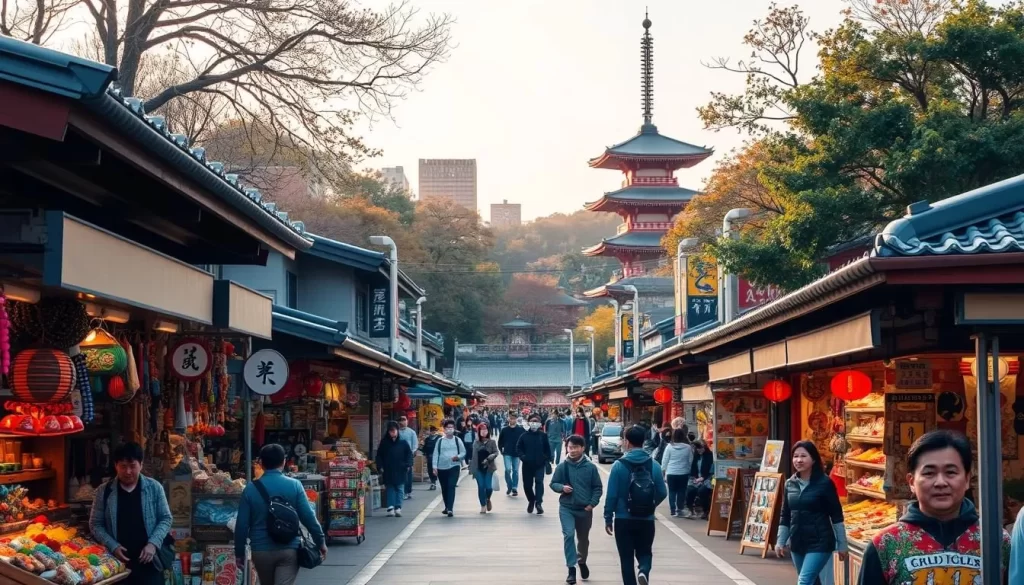
Seasonal Events and Festivals
Throughout the year, Ueno Park transforms with the seasons, offering a range of cultural events and festivals. You can experience a variety of unique cultural experiences and festive atmospheres, making each visit distinct.
Spring and Summer Events
Spring brings the famous Cherry Blossom Festival (Sakura Matsuri), where the park is adorned with food stalls, performances, and special illuminations that enhance the beauty of the blooming trees. During summer, enjoy the Ueno Summer Festival featuring traditional performances and the spectacular lotus blooms on Shinobazu Pond.
| Season | Event | Highlights |
|---|---|---|
| Spring | Cherry Blossom Festival | Food stalls, performances, illuminations |
| Summer | Ueno Summer Festival | Lotus blooms, traditional performances |
| Fall | Autumn Foliage | Vibrant autumn leaves, cultural events |
| Winter | Winter Illuminations | Magical light displays, New Year celebrations |
Fall and Winter Celebrations
As fall arrives, the park is transformed with vibrant autumn foliage, particularly the golden ginkgo trees, accompanied by cultural events. In winter, the park’s illuminations create a magical atmosphere, with special light displays during the December holiday season and New Year celebrations.
Nearby Attractions
Ueno Park serves as a gateway to experiencing the contrasting facets of Tokyo, from modern pop culture to traditional heritage. You can easily spend a day exploring the park and its surrounding neighborhoods.
Akihabara Electric Town
Akihabara, just a 15-minute walk from Ueno Park, is Tokyo’s electronic and anime hub. You’ll find multi-story shops dedicated to electronics, collectibles, and pop culture merchandise, immersing you in Japan’s vibrant anime and gaming culture.
Yanaka District
The historic Yanaka district offers a tranquil atmosphere with its well-preserved traditional architecture and quiet temple grounds. You can visit Yanaka Cemetery, a significant burial ground featuring the graves of many historical figures, and enjoy traditional eateries and craft food shops.
Both Akihabara and Yanaka provide a unique experience of Tokyo’s city life, showcasing its ability to blend tradition with modernity. You can incorporate these visits into a single day trip, making the most of your time in this vibrant city.
| Attraction | Distance from Ueno Park | Highlights |
|---|---|---|
| Akihabara Electric Town | 1.2 km, 15-minute walk | Anime, manga, electronics, pop culture |
| Yanaka District | North of Ueno Park | Traditional architecture, Yanaka Cemetery, craft food |
Visiting these areas allows you to experience the diverse aspects of Tokyo, from the modern pop culture phenomena in Akihabara to the traditional charm of Yanaka, all within a short distance from Ueno Park, making it an ideal place to explore.
Conclusion: Why Ueno Park Is a Must-Visit Destination in Tokyo
As you explore Tokyo, Ueno Park emerges as a must-visit location, combining art, history, and science in a unique way. The park is home to six museums, making it an ideal destination for those interested in culture and education.
Ueno Park offers an unparalleled concentration of cultural, historical, and natural attractions, providing a comprehensive Japanese experience. You can spend at least a day exploring the park’s diverse offerings, from world-class museums like the Tokyo National Museum to historic temples and seasonal events.
In Tokyo, Ueno Park stands out as a premier destination, making it an ideal starting point for your journey.
The above is subject to change.
Check back often to TRAVEL.COM for the latest travel tips and deals.
